Removal Procedure
The flange of the windshield opening, the reveal molding,
and the window may reveal the cause of a broken windshield. This may help
prevent future breakage.
Look for high weld or solder spots, hardened spot weld sealer, or any
other obstruction or irregularity in the flange.
Inspect the windshield that is to be installed for chipped edges. Chipped
edges may be ground off, restoring a smooth edge to the window. This minimizes
the concentration of pressure that causes breakage. Remove no more
than necessary in order to maintain the original shape of the window
and the proper clearance between the window and the flange of the opening.
Tools Required
| • | J 39032 Stationary
Window Removal Tool |
| • | Solvent for cleaning the edge of the window (GM Glass Cleaner
P/N 1050427 or isopropyl alcohol) |
| • | Household cartridge-type caulking gun |
| • | Commercial-type razor knife (for cutting around the edge of the
window) |
- Place protective coverings around the window removal area.
- Remove the windshield wiper arms. Refer to
Windshield Wiper Arm Replacement
in Windshield Wiper/Washer
System.
- Remove rear view Mirror. Refer to
Inside Rearview Mirror Replacement
- Remove the air inlet grille. Refer to
Air Intake Baffle Replacement - Radiator
in Body Front End.
- Remove the door weather-strip from the windshield area.
- Remove the frame filler panel.
- Remove the windshield reveal molding screws.
- Remove the windshield reveal molding.
Pull one end of the molding away from the adhesive unit until the molding
is removed.
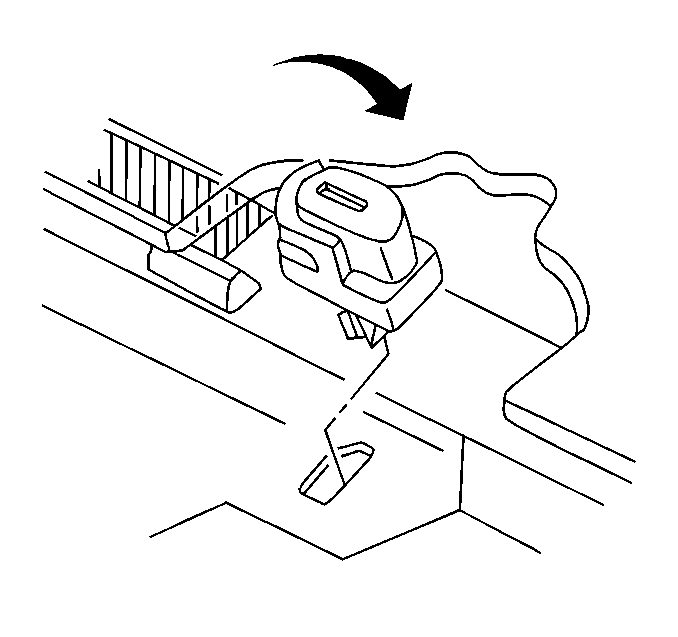
- Remove the lower supports.
- Use one of the following procedures in order to remove the windshield
from the flange:
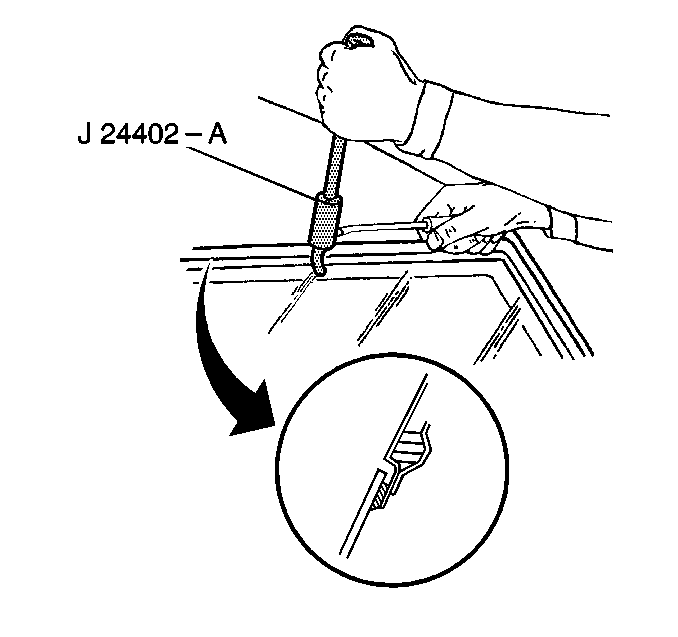
- If you are using Method 1,
perform the following steps:
Method 1
| 11.1. | Use the J 24402-A
in order to cut the window from the urethane adhesive. |
Keep the cutting edge of the knife against the window and cut the urethane
adhesive from the windshield.
| 11.2. | Remove the windshield with the help of an assistant. |

- If you are using Method 2,
perform the following steps:
Method 2
| 12.1. | Use the J 39032
in order to cut the window from the urethane adhesive. |
Keep the cutting edge of the knife against the window and cut the urethane
adhesive from the windshield.
| 12.2. | Remove the windshield with the help of an assistant. |
- Clean the surface of the window which the urethane adhesive will
contact (around the edge of the inside surface) with a clean isopropyl alcohol-dampened
cloth, or with GM Window Cleaner P/N 1050427 or the equivalent.
Installation Procedure

- Install the lower supports.
- Install the spacers and the VIN plate filler strip.
- With the aid of an assistant, dry fit the window in the opening
in order to determine the correct position. Use the following procedure:
| 3.1. | Position the window in the opening. |
| 3.2. | Use masking tape in order to mark the location of the window in
the opening. |
| 3.3. | Slit the masking tape at the window edge. |
| 3.4. | Remove the window from the opening and place the window on a clean,
protected surface. |
Important:
| • | If corrosion of the pinchweld frame is present, or if sheet metal
repairs or replacements are required, the pinchweld flange must be refinished
in order to present a clean primer-only surface. |
| • | If paint repairs are required, mask the flange bonding area (prior
to applying the color coat) in order to provide a clean, primer only surface. |
| • | After repairing the opening as indicated, shake the pinchweld
primer #3 (black) well. Use a dauber in order to apply a second primer
coat to the primed surface of the flange in the bonding area. Allow
the primer to dry for 10 minutes. |
- If performing an extended method installation, shake pinchweld primer #3
(black) well. Apply the primer to any exposed painted surfaces (or scratches
to bare metal) on the pinchweld flange. Allow the primer to dry for
10 minutes. If the short method is used, do not prime the existing
bead of urethane adhesive on the body.
- If the original window is being reused, remove any existing urethane
adhesive from the window edge and surface, using a razor knife or the equivalent.
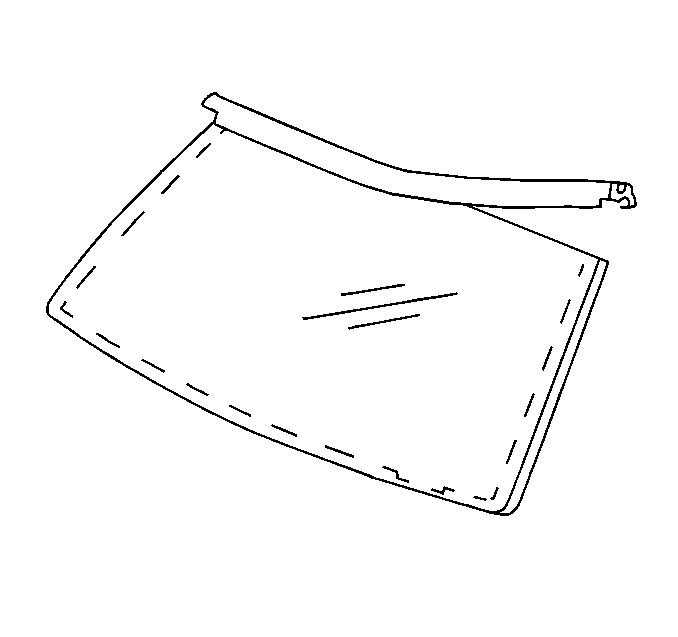
- Install a new acoustic
strip on the windshield, if necessary.
- If the extended method is used, apply a dam material, such as
Norton Windshield Dam Replacement, or the equivalent. Apply 16 mm (0.6 in)
wide around all edges of the glass 1 mm (0.03 in) inboard
from the upper reveal molding, 8 mm (0.3 in) from
the bottom of the glass, and 10.5 mm (0.4 in) inboard
from the left and right sides of the glass. Immediately wipe off
the excess material.
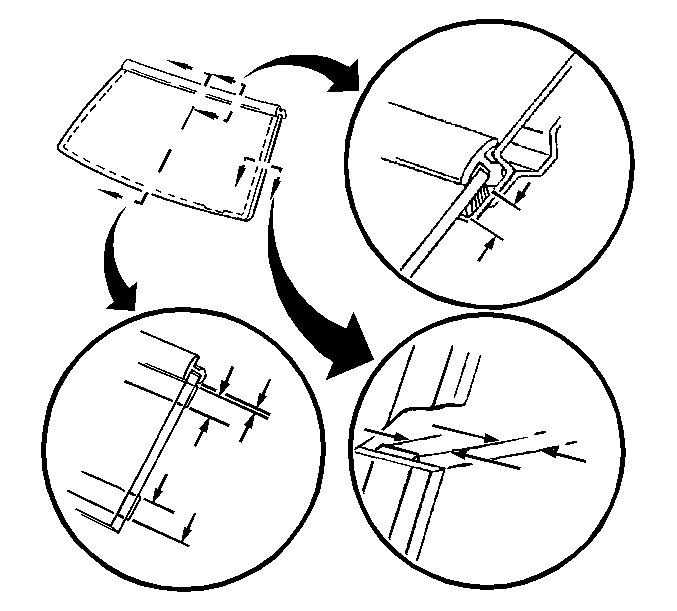
Important: Take care in order to prevent window prep #1 (clear) from running
into the vision area of the window. This primer dries almost instantly, but
may stain the viewing area of the window if not applied evenly.
- Use a new dauber in order to apply glass prep #1 (clear) for
approximately 16 mm (0.6 in) wide around all edges of the glass
1 mm (0.03 in) board from the upper reveal
molding, 8 mm (0.3 in) from the bottom of the
glass, and 10.5 mm (0.4 in) inboard from the left and
right sides of the glass. Immediately wipe off the excess using a
clean cloth.
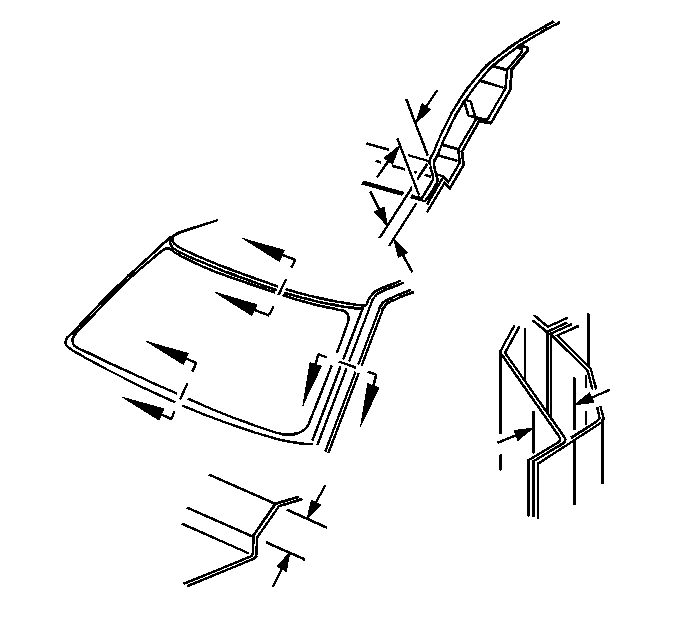
- Shake window primer #2
(black) well. Use a new dauber in order to apply the primer to the same areas
that you applied window prep #1 (clear). Allow the primer to dry for
6-10 minutes.
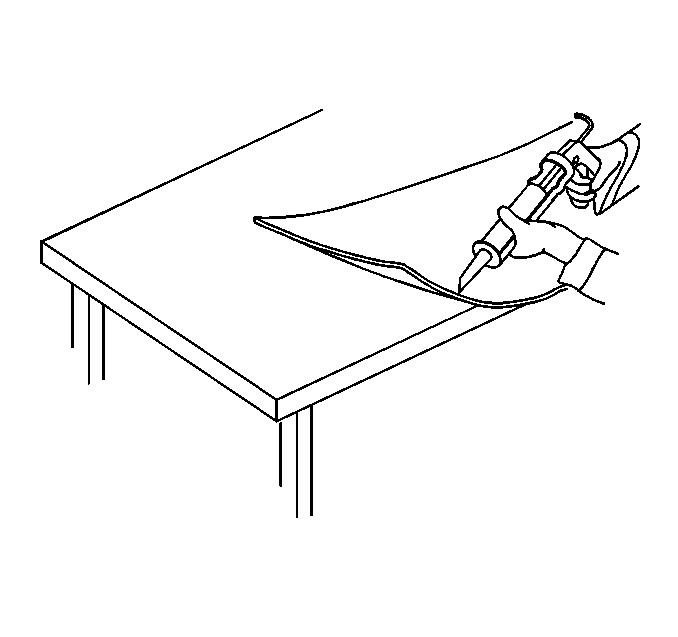
- If you use the short method,
cut the tip of the application nozzle in order to provide a bead of 6 mm
(1/4 in) in diameter. If you use the extended method, cut the
applicator nozzle in order to provide a bead of approximately 16 mm
(0.6 in).
- If you are using the short method, use a cartridge type caulking
gun in order to apply a smooth, continuous bead of urethane adhesive to the
existing bead of urethane adhesive on the body.
- If you are using the extended method, use the edge of the window
(or the inside edge of the reveal molding in certain cases) as a guide for
the nozzle and apply urethane adhesive to the inner surface of the
window.
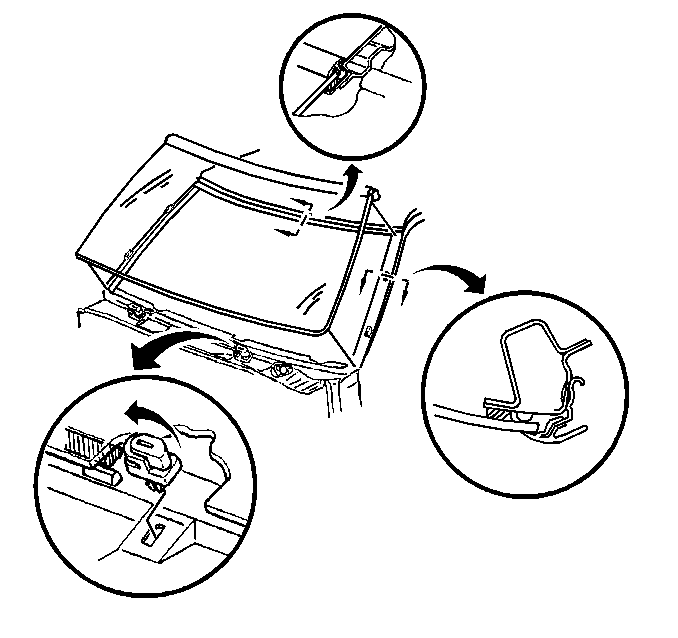
- Use rubber suction cups,
and with the aid of a helper, install the window to the opening.
| 13.1. | Place the window on the lower supports. |
| 13.2. | Align the tape lines on the window and the body pillar. |
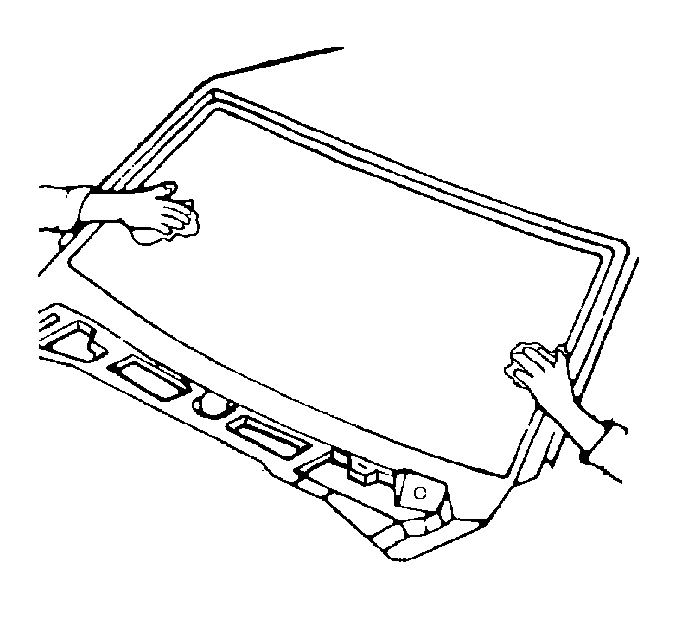
- Firmly press the window
into place.
- Tape the window to the body in order to minimize movement and
clean up any urethane squeezed out from the body.
- Use a soft spray in order to watertest the window immediately.
Refer to
Body Waterleak Repair
in
Waterleaks.
| • | Warm or hot water is preferred in order to accelerate the cure
of the adhesive. |
| • | Do not direct a hard stream of high pressure water at fresh urethane
adhesive. |
| • | If leaks are found, apply extra urethane adhesive at the leak
point with a plastic paddle. |
- Install the windshield reveal molding.
- Install the windshield reveal molding screws and clip.
- Install the door frame weather-stripping to the windshield area.
- Install the air inlet grille. Refer to
Air Intake Baffle Replacement - Radiator
in Body Front End.
- Install the rear view mirror. Refer to
Inside Rearview Mirror Replacement
- Install the windshield wiper arms. Refer to
Windshield Wiper Arm Replacement
in Windshield Wiper/Washer
System.
Important:
| • | Allow the vehicle to remain at room temperature (22°C/72°F
at 30 percent relative humidity) for a minimum of 6 hours. |
| • | Partially lower a door window in order to prevent pressure build
ups when closing the doors prior to urethane adhesive cure. |
| • | Do not drive the vehicle until the urethane adhesive is cured
(minimum of 6 hours at room temperature). |
| • | Do not use compressed air in order to dry the urethane adhesive. |
- Remove the tape from the painted surfaces.










